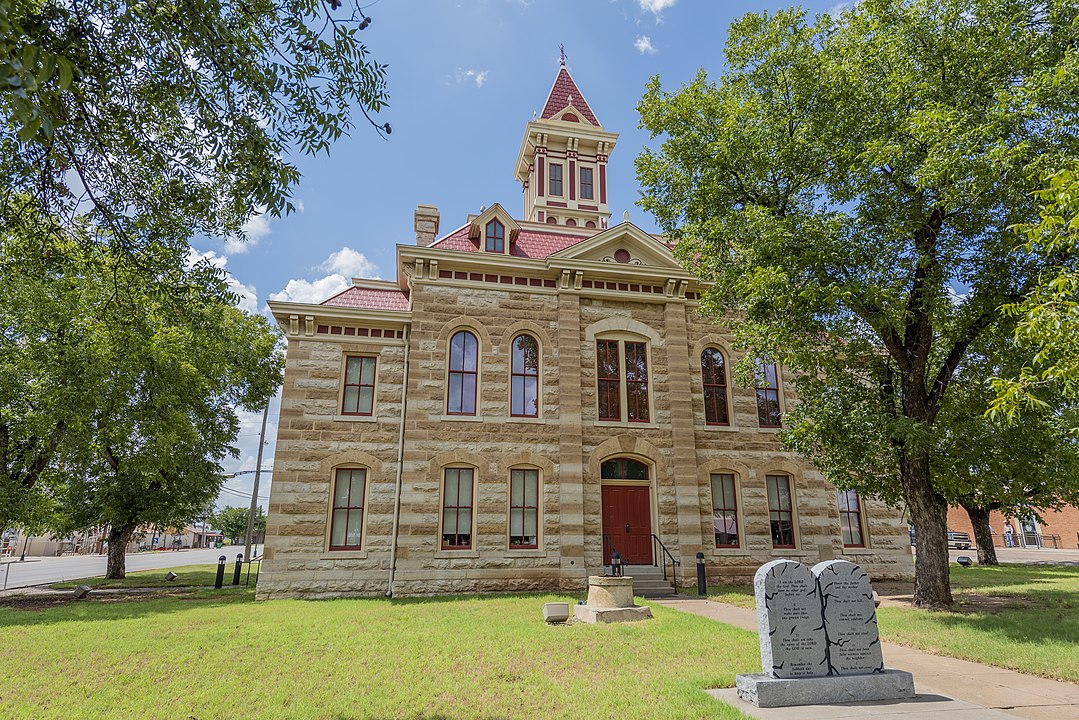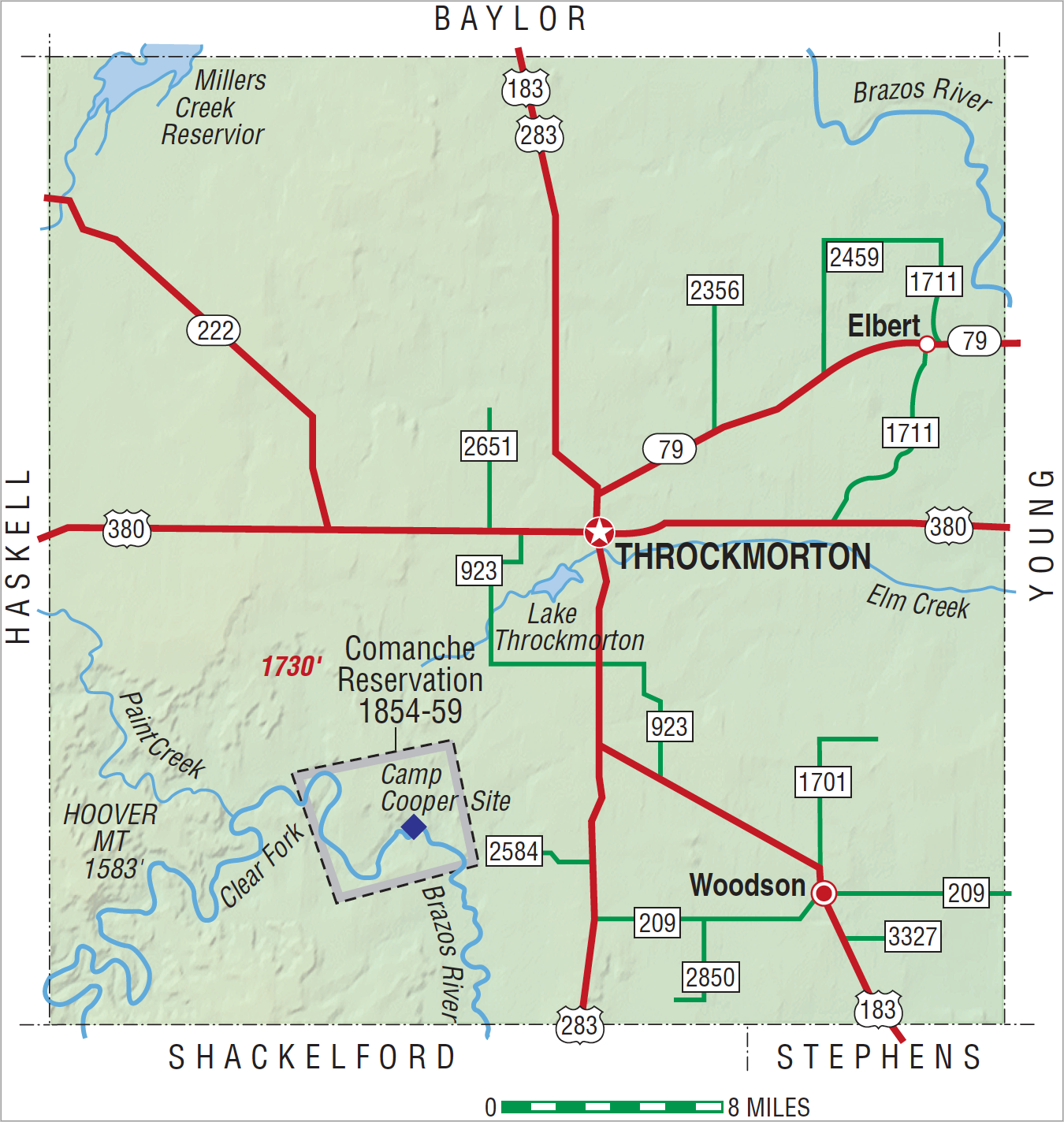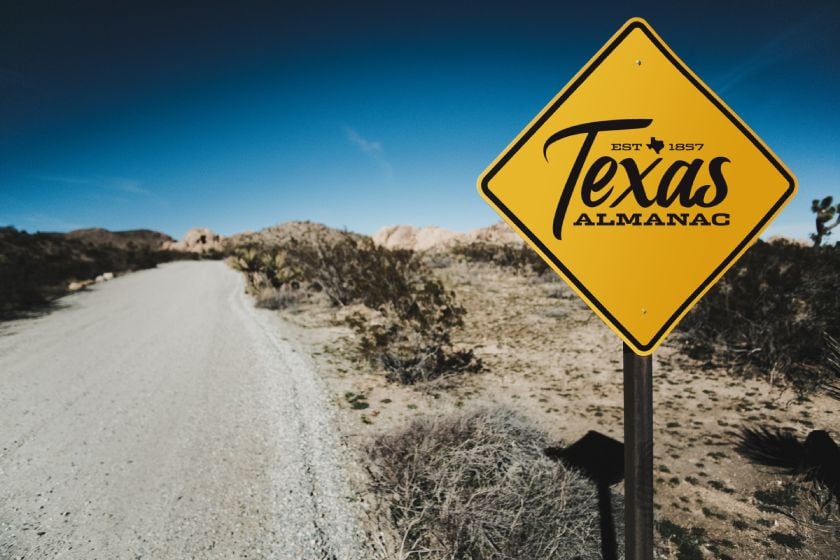Throckmorton County

Throckmorton County, Texas

Throckmorton County, Texas

Throckmorton County is in north central Texas. The center of the county lies at 33°10' north latitude and 99°10' west longitude; the town of Throckmorton, the county's seat of government, is fifty-eight air miles southwest of Wichita Falls. The area was named for William E. Throckmorton, an early settler on the north Texas frontier. Throckmorton County encompasses 915 square miles of rolling country with red to black soils drained by the Clear Fork and Salt Fork of the Brazos River; elevations range between 1,200 to 1,800 feet above sea level. Hills are prominent in the southwestern sections. The county is in the Rolling Plains vegetation region and is covered by bluestem, gramas, wildryes, and wheat grass, along with some mesquite trees. Annual rainfall averages twenty-six inches. Temperatures range from an average minimum of 29° F in January to an average maximum of 98° in July. The average growing season lasts 220 days. The major arteries of the area's transportation network are U.S. Highway 380, U.S. Highway 283, and State Highway 79, which crosses through the northeastern part of the county to the town of Throckmorton. Mineral resources in the county include limestone, sand and gravel, petroleum, natural gas, and bituminous coal.
The area that is now Throckmorton County was a part of Red River Municipality until 1837, when it became part of mewly organized Fannin County. In 1854 the Comanche Indian Reservation, (18,576 acres), was established at Camp Cooper on the Clear Fork of the Brazos. In 1855 some 450 Comanches of the Penateka band settled there and tried to adapt to an agricultural economy. John R. Baylor, Indian agent from 1855 to 1857, settled his family at CampCooper in 1856. That same year Lt. Newton C. Givens built a stone ranch house near the old California Trail and the Haskell county line. At the time this was the last house between Texas and New Mexico settlements. The Butterfield Overland Mail route crossed the area, and Franz Station was a well-known stop. The Texas legislature established Throckmorton County in 1858, and Williamsburg initially was chosen to be the county seat. In 1859 the Comanche reservation was relocated to Indian Territory, and by 1860 the United States census found only 124 people living in the county. The outbreak of the Civil War also impeded settlement of the area, and the county remained unorganized for almost twenty years after it was formed. Throckmorton County was organized in 1879, and the town of Throckmorton, located near the center of the county, became the county seat. Early businesses included a store operated by a Mr. Tadley and a restaurant-stage stand run by C. A. (Alex) Housley. By 1880 sixty-eight ranches or farms operated in the area. Though some crops were raised, cattle ranching was the mainstay of the economy. Fewer than 900 acres was planted in corn, the county's most important crop in 1880, while almost 32,000 cattle and more than 7,000 sheep were reported on ranches that year. Ranching continued to dominate the economy during the 1880s and 1890s, and by 1900 almost 47,000 cattle and 4,000 sheep were reported. Crop farming slowly expanded during this period, however. By 1900 almost 5,000 acres was planted in corn, and 3,000 acres was devoted to cotton. There were 272 farms and ranches, encompassing 635,000 acres, that year. As agriculture expanded in the area, the population rose to 902 by 1890 and to 1,750 by 1900. One of the most important ranches in the area, the SMS Ranch, was put into operation during the late nineteenth century. Swante M. Swenson gained railroad and other lands in parts of Throckmorton, Jones, Shackelford, Haskell, and Stonewall counties in 1854. His sons, E. P. and S. A. Swenson, began fencing and running cattle on the lands in the early 1880s. It took years of investment and work to improve the ranches and the cattle breed, but by 1902 when Frank S. Hastings became manager the "breed-well . . . feed-well" practice was paying off. The Swensons had 25,000 cattle on 350,000 acres, and Hastings began sending range-bred calves to be matured at feed lots in the Corn Belt. Hastings remained manager until his death in 1922.
John Leffler | © TSHA

Adapted from the official Handbook of Texas, a state encyclopedia developed by Texas State Historical Association (TSHA). It is an authoritative source of trusted historical records.

- ✅ Adoption Status:
- This place is available for adoption! Available for adoption!
- Adopted by:
- Your name goes here
- Dedication Message:
- Your message goes here
Currently Exists
Yes
Place type
Throckmorton County is classified as a County
Altitude Range
1100 ft – 1730 ft
Size
Land area does not include water surface area, whereas total area does
- Land Area: 912.6 mi²
- Total Area: 915.5 mi²
Temperature
January mean minimum:
29.6°F
July mean maximum:
95.8°F
Rainfall, 2019
29.8 inches
Population Count, 2019
1,501
Civilian Labor Count, 2019
589
Unemployment, 2019
5.9%
Property Values, 2019
$910,296,890 USD
Per-Capita Income, 2019
$35,941 USD
Retail Sales, 2019
$9,577,547 USD
Wages, 2019
$3,163,861 USD
County Map of Texas
Throckmorton County
- Throckmorton County
Places of Throckmorton County
| Place | Type | Population (Year/Source) | Currently Exists |
|---|---|---|---|
| Town | – | – | |
| Town | 8 (2021) | Yes | |
| Town | – | – | |
| Town | – | – | |
| Town | – | – | |
| Lake | – | Yes | |
| Town | – | – | |
| Town | – | – | |
| Town | – | – | |
| Town | – | – | |
| Town | 749 (2021) | Yes | |
| Town | – | – | |
| Town | 229 (2021) | Yes |

Proud to call Texas home?
Put your name on the town, county, or lake of your choice.
Search Places »
